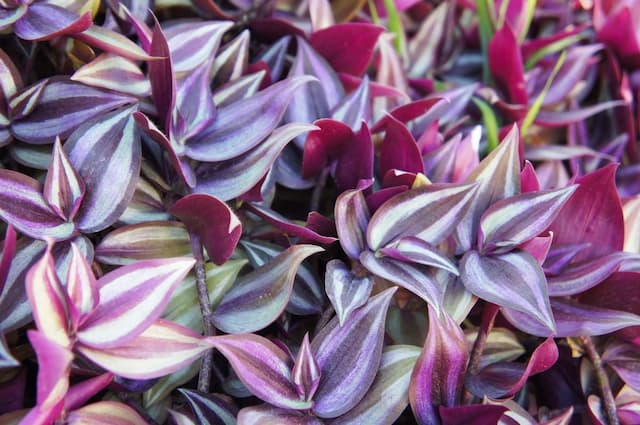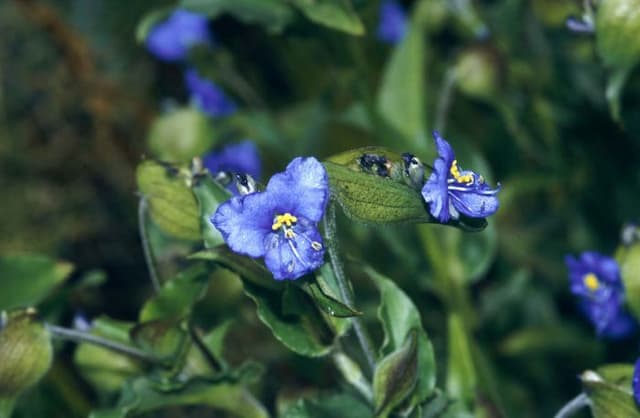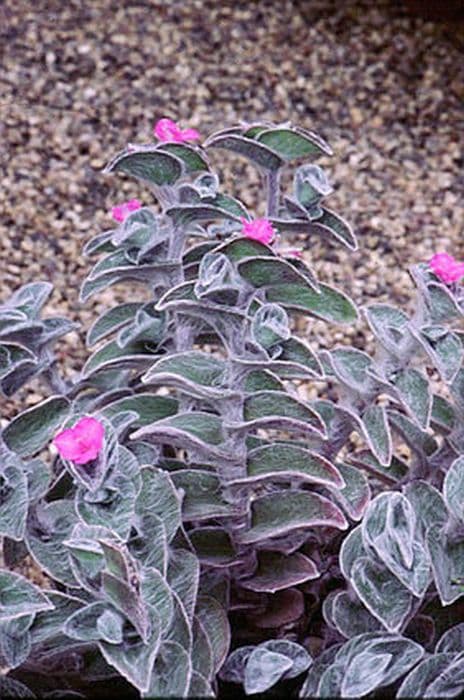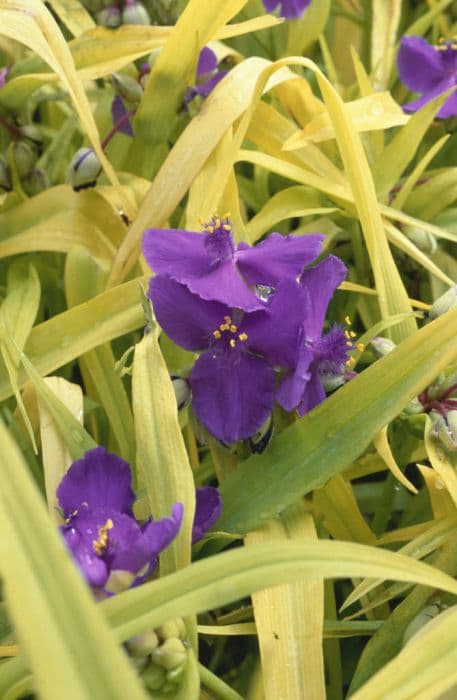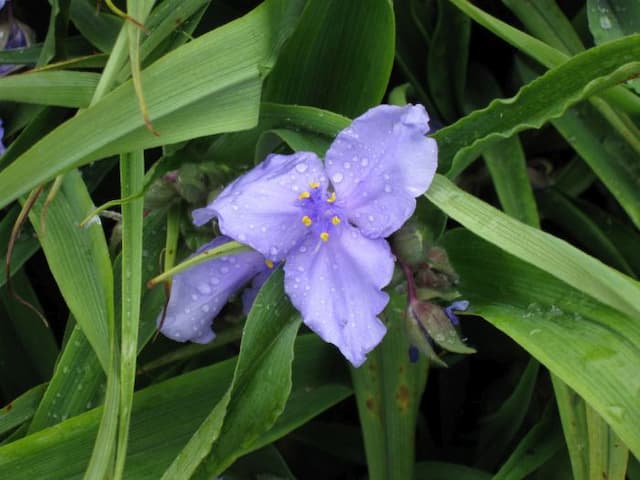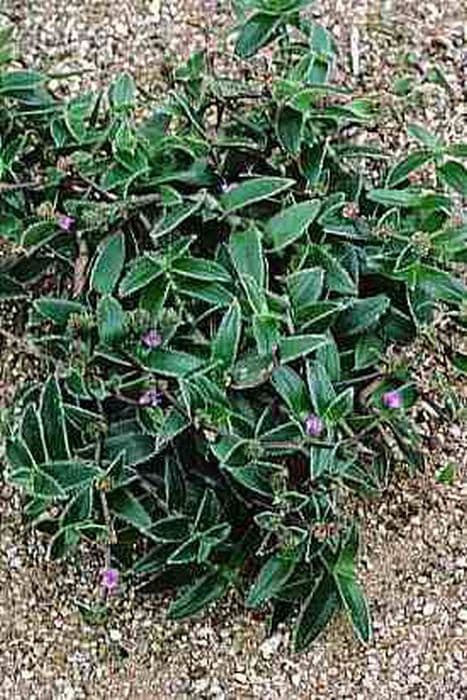Spiderwort Tradescantia (Andersoniana Group) 'Bilberry Ice'

ABOUT
The plant known as 'Bilberry Ice' is part of the Spiderwort group, showcasing an eye-catching display of foliage and flowers. The leaves are long and slender, presenting a lush green color that serves as a background to the true spectacle—the blooms. The flowers are the stars of the show with their distinctive coloration. Each flower consists of three petals and exhibits a frosty white hue, blended with soft lilac to purple undertones, creating a cool, icy appearance as suggested by the name 'Bilberry Ice.' These delicate blooms form in clusters, making them very noticeable against the green backdrop of the foliage. The petals are slightly rounded with a gentle taper towards their tips, which may occasionally showcase small streaks or dots in deeper purple, adding to their uniqueness. The contrast between the purplish flowers and the greenery is quite striking, and the plant grows in a bushy, clumping manner that gives it a full and lush appearance, brimming with colors that enchant the beholder.
About this plant
 Names
NamesFamily
Commelinaceae
Synonyms
Spiderwort, Widow's Tears, Trinity Flower
Common names
Tradescantia x andersoniana 'Bilberry Ice'.
 Toxicity
ToxicityTo humans
Spiderwort, including the 'Bilberry Ice' variety, is generally considered non-toxic to humans. Therefore, it does not typically cause poisoning or adverse effects if ingested. However, it is always advisable to avoid eating any part of ornamental plants due to the potential of individual allergic reactions or gastrointestinal discomfort.
To pets
Spiderwort, known as 'Bilberry Ice' in the Andersoniana Group, is usually regarded as non-toxic to pets. Consumption of this plant by dogs, cats, or other household pets should not result in poisoning. Nonetheless, ingestion of non-food plants can sometimes cause mild gastrointestinal upset in pets, such as vomiting or diarrhea, so it is still best to prevent pets from eating ornamental plants.
 Characteristics
CharacteristicsLife cycle
Perennials
Foliage type
Deciduous
Color of leaves
Green
Flower color
Lilac
Height
1-2 feet (30-60 cm)
Spread
1-2 feet (30-60 cm)
Plant type
Herb
Hardiness zones
4-9
Native area
North America
Benefits
 General Benefits
General Benefits- Easy to Care For - Tradescantia 'Bilberry Ice' is tolerant of various conditions and can be easily maintained with minimal care.
- Drought Tolerant - Once established, it can withstand periods of low water, making it suitable for xeriscaping or drought-prone areas.
- Low Maintenance - This plant does not require frequent pruning or feeding, saving time and effort for gardeners.
- Attracts Pollinators - The flowers of 'Bilberry Ice' attract bees and butterflies, supporting local ecosystems and pollination.
- Ground Cover - Its spreading habit makes it an excellent ground cover that can prevent weeds and cover bare spots in the garden.
- Ornamental Value - The plant's attractive foliage and contrasting icy blue flowers offer visual interest throughout the growing season.
- Adaptable to Containers - Tradescantia 'Bilberry Ice' can be grown in pots, making it versatile for patios, balconies, and indoor settings.
- Edging Plant - Its compact and tidy growth habit makes it suitable for edging paths and garden borders.
- Rapid Growth - It grows quickly and provides fast coverage, making it ideal for new gardens or filling in gaps.
- Seasonal Interest - Provides color and texture in the garden from spring through autumn.
 Medical Properties
Medical PropertiesThis plant is not used for medical purposes.
 Air-purifying Qualities
Air-purifying QualitiesThis plant is not specifically known for air purifying qualities.
 Other Uses
Other Uses- Photography Subject: Tradescantia 'Bilberry Ice', with its distinctive purple and white blooms, can offer a unique subject for photographers, particularly those specializing in macro or garden photography.
- Art Inspiration: Artists can draw inspiration from the vivid colors and patterns of the Tradescantia 'Bilberry Ice' for paintings, prints, and textile designs.
- Edging Plants: Due to their low-growing habit, these plants can be used to create attractive borders along garden pathways or flower beds.
- Hanging Baskets: The trailing nature of Tradescantia 'Bilberry Ice' makes it ideal for use in hanging baskets, adding a vertical interest to balconies and patios.
- Educational Tool: In schools, Tradescantia 'Bilberry Ice' can be used to teach children about plant biology and propagation, as it roots easily from cuttings.
- Floral Arrangements: The flowers of Tradescantia 'Bilberry Ice' add a pop of color to both fresh and dried floral arrangements.
- Living Mulch: When planted densely, Tradescantia 'Bilberry Ice' can act as living mulch, suppressing weeds and helping to retain soil moisture.
- Garden Accent: Strategic planting of this colorful variety can draw the eye and act as an accent in monochromatic or green-focused garden designs.
- Craft Projects: The flowers and leaves of Tradescantia 'Bilberry Ice' can be used in craft projects, such as pressing for bookmarks or cards.
- Eco-Friendly Confetti: The petals of this plant can be used as a biodegradable confetti alternative in celebrations for a more environmentally-friendly option.
Interesting Facts
 Feng Shui
Feng ShuiThe Spiderwort is not used in Feng Shui practice.
 Zodiac Sign Compitability
Zodiac Sign CompitabilityThe Spiderwort is not used in astrology practice.
 Plant Symbolism
Plant Symbolism- Adaptability: Tradescantia, commonly known as Spiderwort, is a hardy plant that adapts easily to different environments, symbolizing the ability to thrive in various conditions.
- Simplicity: Spiderwort has a straightforward, unpretentious growth habit, representing simplicity and the beauty in everyday things.
- Transience: The individual flowers of Spiderwort often last just one day, symbolizing fleeting beauty and the transient nature of life.
- Survival: Due to Spiderwort's resilience and ability to grow in diverse conditions, it embodies the spirit of survival and endurance.
 Water
WaterThe Spiderwort, commonly referred to by its botanical name Tradescantia 'Bilberry Ice', prefers consistent moisture but the soil should not be waterlogged. Water the plant thoroughly when the top inch of soil feels dry to the touch, which might be approximately once a week, but this can vary depending on environmental conditions such as temperature and humidity. Use room-temperature water, and pour slowly at the base of the plant until excess water begins to drain from the bottom of the pot, suggesting the soil is fully saturated. In terms of a fixed amount, this might average around 16-32 ounces of water for a medium-sized pot during each watering session, adjusting for the plant's size and the seasonal changes in growth and temperature.
 Light
LightSpiderwort thrives best in partial shade to full sun. The ideal location for Tradescantia 'Bilberry Ice' would be a spot where it receives bright, indirect light for several hours each day, with some direct morning sun if possible. Avoid strong, direct afternoon sunlight which can scorch the leaves. East or west-facing windowsills are typically good spots that provide the right light conditions.
 Temperature
TemperatureSpiderwort prefers moderate temperatures and will do best in a range that falls between 55°F and 75°F. Tradescantia 'Bilberry Ice' can tolerate temperatures as low as 45°F and as high as 90°F but should be protected from extreme cold and frost, which can be damaging to the plant. Maintaining temperatures within this range will promote healthy growth and flowering.
 Pruning
PruningPruning is essential for the Spiderwort to maintain its shape and encourage bushier growth. Tradescantia 'Bilberry Ice' should be pruned in early spring or after the blooming period has ended. Deadheading, or the removal of spent flowers, will promote further blooming. Cut back leggy stems to stimulate new growth and to keep the plant looking full and vibrant.
 Cleaning
CleaningAs needed
 Soil
SoilSpiderwort 'Bilberry Ice' grows best in a well-draining soil mix, such as a blend of peat, loam, and sand, with added perlite or vermiculite for aeration. This plant prefers a slightly acidic to neutral pH range of 6.0 to 7.0.
 Repotting
RepottingSpiderwort 'Bilberry Ice' should typically be repotted every 2-3 years, or when it outgrows its current pot, to provide fresh soil and additional space for root growth.
 Humidity & Misting
Humidity & MistingSpiderwort 'Bilberry Ice' thrives in moderate to high humidity levels, making it well-suited to bathrooms or kitchens where humidity tends to be higher, but regular household humidity is generally sufficient.
 Suitable locations
Suitable locationsIndoor
Provide indirect light, keep moist, and offer regular humidity.
Outdoor
Place in partial shade, protect from harsh sun, keep soil moist.
Hardiness zone
4-9 USDA
 Life cycle
Life cycleTradescantia 'Bilberry Ice', also known as Spiderwort, begins its life cycle with seed germination, typically in the spring when the temperature and soil conditions are conducive to growth. The seeds develop into seedlings, which gradually grow into vegetative plants with characteristic long, pointed leaves and sturdy stems. During the flowering stage in late spring to summer, 'Bilberry Ice' produces clusters of purple to pink and white three-petaled flowers that attract pollinators. After pollination, the flowers may form capsules containing seeds, allowing for dispersal and propagation. The plant can also spread asexually through rooting at nodes or division of the clumps. As a perennial, Spiderwort dies back to the ground in the fall or winter, regrow from the roots in the subsequent growing season.
 Propogation
PropogationPropogation time
Spring-Early Summer
The most popular method of propagating Tradescantia (Andersoniana Group) 'Bilberry Ice', commonly known as Spiderwort, is by division. This is typically done in the spring or early summer when the plant's growth is most vigorous. To propagate by division, carefully dig up the entire plant and gently separate the clumps into smaller sections, ensuring that each new section has a good amount of roots attached. These divided sections can then be immediately replanted into well-preparing soil, ideally in a spot that is partially shaded to prevent stress from direct sunlight. Adequate watering after replanting helps to establish the new divisions. Within a few weeks, these sections will establish themselves as new plants, continuing to grow and spread in their new locations.
